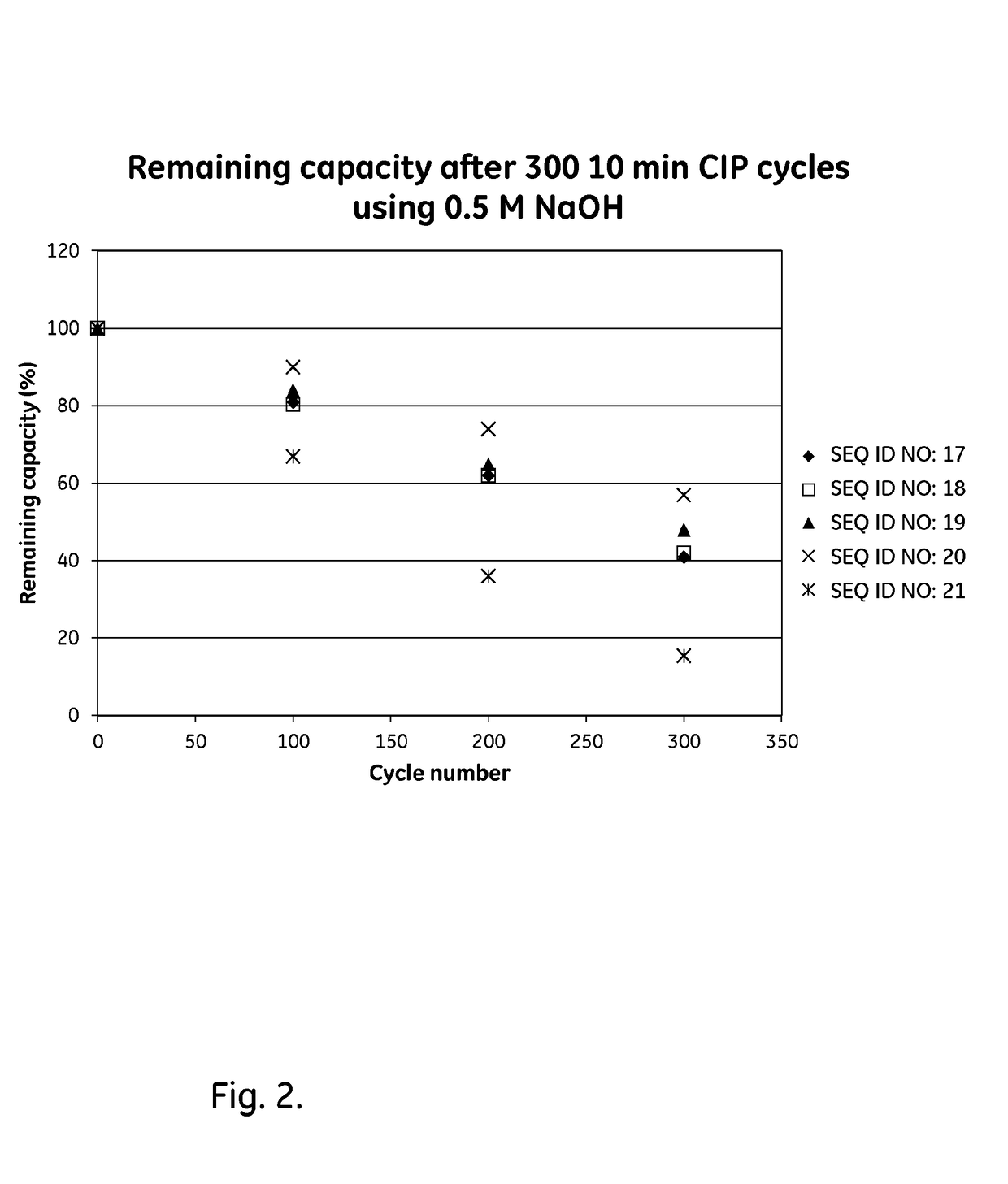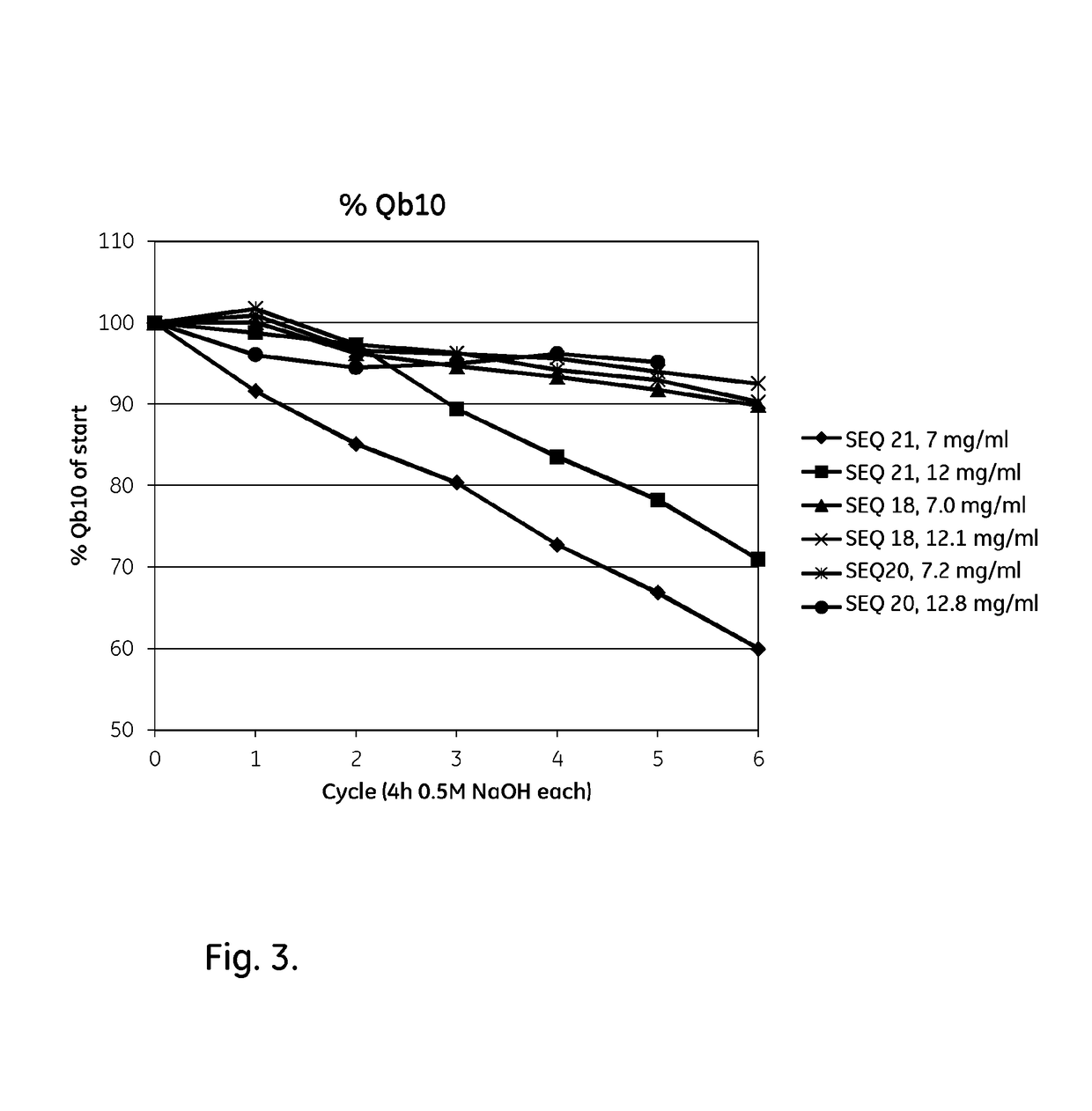Mutated Immunoglobulin-Binding Polypeptides
a polypeptide and immunoglobulin technology, applied in the field of affinity chromatography, can solve the problems of inability to achieve complete cleaning, and inability to achieve complete cleaning, and achieve the effect of improving alkaline stability
- Summary
- Abstract
- Description
- Claims
- Application Information
AI Technical Summary
Benefits of technology
Problems solved by technology
Method used
Image
Examples
example 1
[0096]The purified monomeric ligands listed in Table 1, further comprising an AQGT leader sequence at the N-terminus and a cysteine at the C terminus, were immobilized on Biacore CM5 sensor chips (GE Healthcare, Sweden), using the amine coupling kit of GE Healthcare (for carbodiimide coupling of amines on the carboxymethyl groups on the chip) in an amount sufficient to give a signal strength of about 200-1500 RU in a Biacore surface plasmon resonance (SPR) instrument (GE Healthcare, Sweden). To follow the IgG binding capacity of the immobilized surface 1 mg / ml human polyclonal IgG (Gammanorm) was flowed over the chip and the signal strength (proportional to the amount of binding) was noted. The surface was then cleaned-in-place (CIP), i.e. flushed with 500mM NaOH for 10 minutes at room temperature (22+ / −2° C.). This was repeated for 96-100 cycles and the immobilized ligand alkaline stability was followed as the remaining IgG binding capacity (signal strength) after each cycle. The r...
example 2
[0097]The purified tetrameric and hexameric ligands listed in Table 2 were immobilized on Biacore CM5 sensor chips (GE Healthcare, Sweden), using the amine coupling kit of GE Healthcare (for carbodiimide coupling of amines on the carboxymethyl groups on the chip) in an amount sufficient to give a signal strength of about 200-1500 RU in a Biacore instrument (GE Healthcare, Sweden) . To follow the IgG binding capacity of the immobilized surface lmg / m1 human polyclonal IgG (Gammanorm) was flowed over the chip and the signal strength (proportional to the amount of binding) was noted. The surface was then cleaned-in-place (CIP), i.e. flushed with 500mM NaOH for 10 minutes at room temperature (22+ / −2° C.). This was repeated for 300 cycles and the immobilized ligand alkaline stability was followed as the remaining IgG binding capacity (signal strength) after each cycle. The results are shown in Table 2 and in FIG. 2 and indicate that at least the ligands Zvar(Q9A,N11E,N43A)4, Zvar(Q9A,N11E...
example 3
[0098]Example 2 was repeated with 100 CIP cycles of three ligands using 1 M NaOH instead of 500 mM as in Example 2. The results are shown in Table 3 and show that all three ligands have an improved alkali stability also in 1M NaOH, compared to the parental structure Zvar4 which was used as a reference.
TABLE 3Tetrameric ligands, evaluated by Biacore (1M NaOH).RemainingCapacitycapacity relative to100ref. 100 LigandSequencecycles (%)cyclesZvar4SEQ ID NO 21271Zvar(Q9A, N11E, N28A, N43A)4SEQ ID NO 18552.04Zvar(Q9A, N11E, Q40V, A42K, SEQ ID NO 19542.00N43E, L441)4Zvar(Q9A, N11E, Q40V, A42K, SEQ ID NO 20562.07N43A, L441)4
PUM
| Property | Measurement | Unit |
|---|---|---|
| temperature | aaaaa | aaaaa |
| pH | aaaaa | aaaaa |
| pore size | aaaaa | aaaaa |
Abstract
Description
Claims
Application Information
 Login to View More
Login to View More - R&D
- Intellectual Property
- Life Sciences
- Materials
- Tech Scout
- Unparalleled Data Quality
- Higher Quality Content
- 60% Fewer Hallucinations
Browse by: Latest US Patents, China's latest patents, Technical Efficacy Thesaurus, Application Domain, Technology Topic, Popular Technical Reports.
© 2025 PatSnap. All rights reserved.Legal|Privacy policy|Modern Slavery Act Transparency Statement|Sitemap|About US| Contact US: help@patsnap.com



